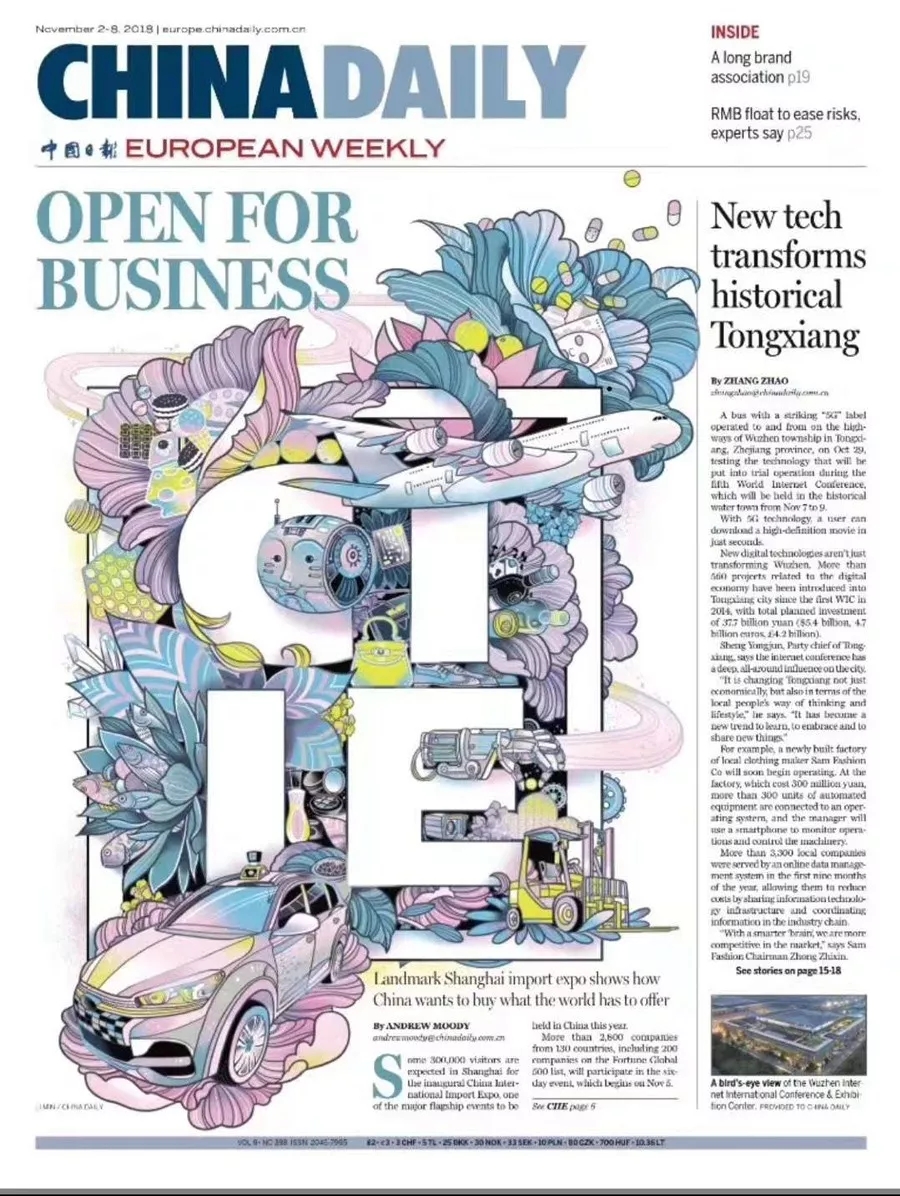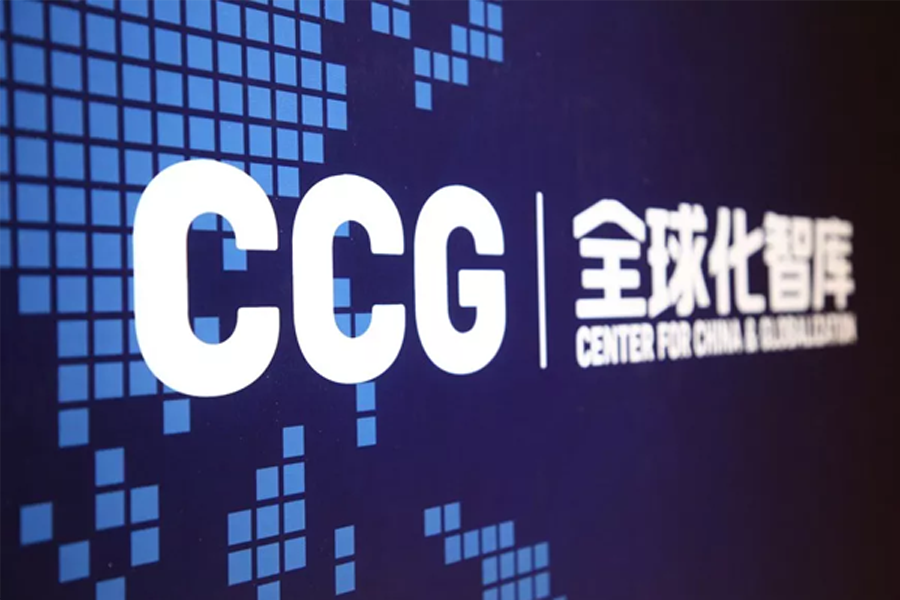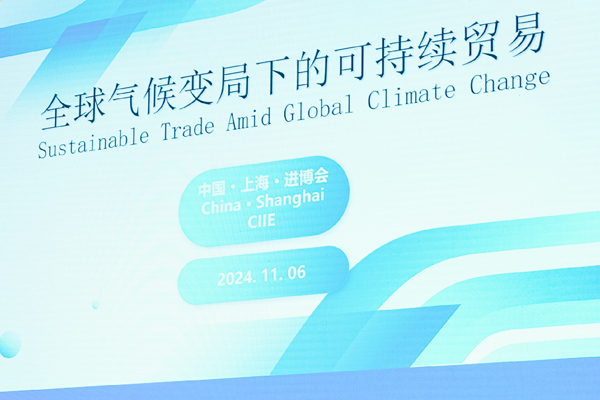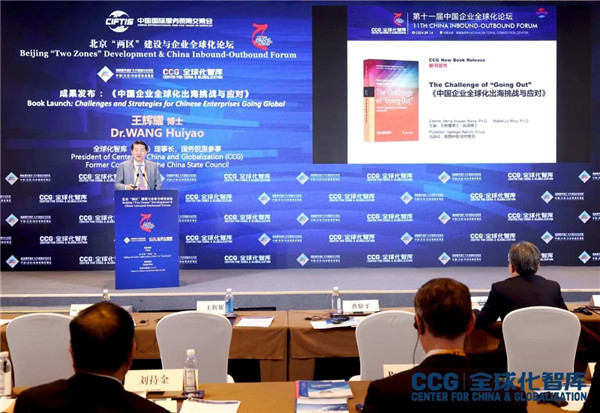【China Daily】Open for business
November 05 , 2018
Landmark Shanghai import expo shows how China wants to buy what the world has to offer
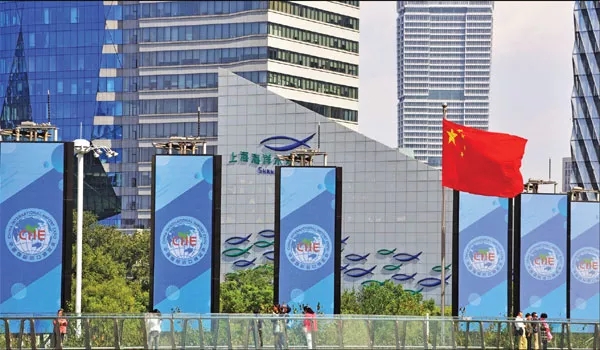
Signs promote the upcoming China International Import Expo in Pudong New Area, Shanghai, on Oct 11. Zhou Dongchao / For China Daily
Thousands of visitors and companies heading to Shanghai
Some 300,000 visitors are expected in Shanghai for the inaugural China International Import Expo, one of the major flagship events to be held in the country this year.
More than 2,800 companies, including 200 Fortune Global 500 ones, from 130 countries will be taking part in the six-day event, which begins on Monday.
The Shanghai expo, which will be held annually, is set to demonstrate clearly to an international audience that the nation’s economy is no longer purely the “Made in China” manufacturing powerhouse of recent years, but is now driven by consumers who want to buy what the world has to offer.
Against a backdrop of increasing international trade tensions, it is also aimed at demonstrating that China is open for business as the country marks the 40th anniversary of reform and opening-up.
Sherri He, a partner at management consultants AT Kearney’s Shanghai office, said it is probably the biggest import-related event ever staged. The scale of the Shanghai expo is much greater than that of the Canton Fair, which has been held twice a year in Guangzhou, capital of Guangdong province, since 1957.
“That would be a comparison point, but that (the Canton Fair) is for both imports and exports. This (the Shanghai expo) is probably the first-ever global import event,” she said.
The exhibitors include a wide range of companies, from those showcasing their expertise in high-end technologies such as industrial robots, machine tools, artificial intelligence and advanced healthcare, to those selling food and luxury consumer goods.
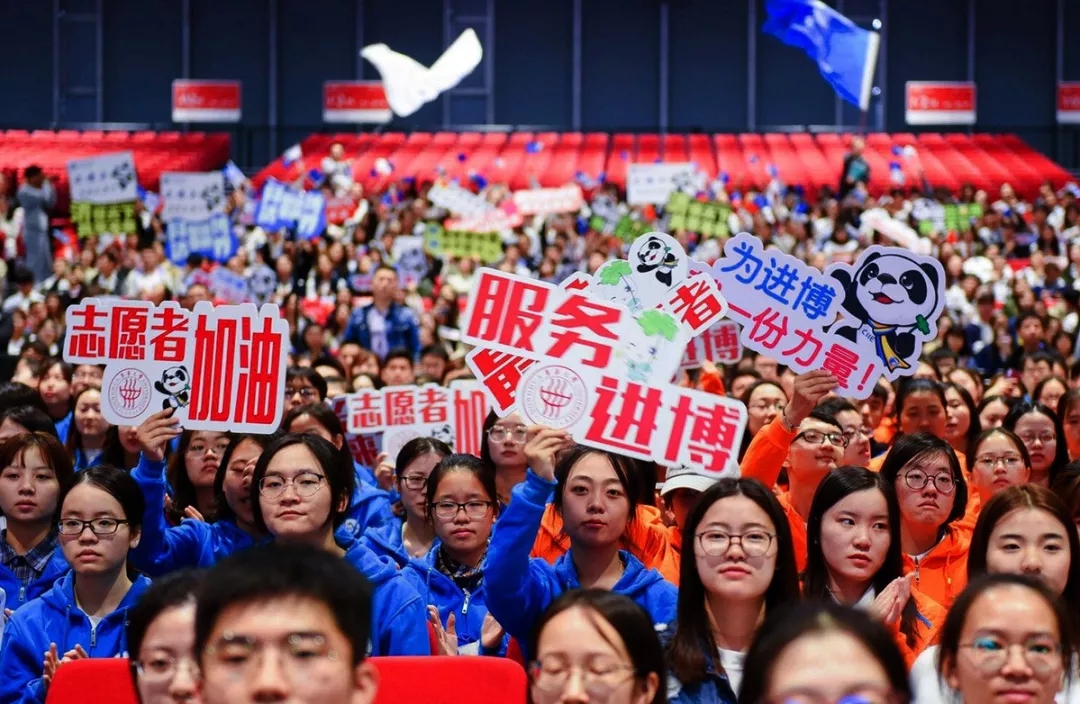
More than 5,000 volunteers prepare to take part in the China International Import Expo in Shanghai, one of the major flagship events to be held in the country this year, attracting an estimated 300,000 visitors from around the world. [Photo/Xinhua]
The main goal for some will be to get close to the Chinese middle-class consumer, whose growth in terms of numbers is set to be one of the global economic megatrends of the coming decades. According to global management consultants McKinsey& Co, the country’s middle class could increase to 630 million by 2022, almost double the current US population of 327 million.
German carmaker BMW is among the high-profile exhibitors. It reconfirmed its commitment to the China market by announcing last month that it would pay 3.6 billion euros ($4.2 billion) to take majority control of its China joint venture with Brilliance China Automotive Holdings.
BMW is taking advantage of new rules designed to open up China’s automotive sector to foreign players announced by President Xi Jinping at the Boao Forum in Hainan province in April.
Jochen Goller, president and CEO of BMW Group Region China, said one of the expo’s aims is to highlight Chinese consumers’ need to upgrade, which he hopes his company can meet through its leading position in autonomous driving and electric cars.
“(This) greatly resonates with the core purpose of the CIIE. We believe the expo is a platform to demonstrate our long-term commitment as well as our confidence to grow with China,” he said.
However, exhibitors will be well aware that the Chinese consumer market, although potentially lucrative, is not an easy one to crack.
Lot of experience

Alina Ma, associate research director in Shanghai for market research company Mintel, said that simply being foreign is no longer such an attraction to Chinese consumers.
“This may have been the case 10 years ago, but no longer. Chinese consumers have now traveled abroad and have a lot of experience. They are particularly savvy when it comes to buying online,” she said.
“They like to compare and contrast product features, and they often find that Chinese products offer what they need and are also value for money.”
Ma said the country’s consumers are also increasingly seeking products with Chinese heritage or value.
“This applies to younger consumers as much as older ones and poses another challenge for foreign companies.”
Mats Harborn, president of the European Union Chamber of Commerce in China, whose Shanghai chapter will release its position paper on the expo on Friday, said 60 percent of its members thought Chinese products were now equally or more innovative than their own.
“It is a signal I want companies to send back to their headquarters. They need to wake up and put their resources in China,” he said.
According to official data, China’s imports are now an important driver of the global economy, with the world’s second-largest economy being also the second-largest importer of goods for nine consecutive years, making up 10.2 percent of global imports last year.
China’s imports of goods in 2017 rose to $1.74 trillion, up by 16 percent on the previous year, whereas its exports rose by 11.4 percent to more than $2.21 trillion.
Louis Kuijs, head of Asia Economics for consultancy Oxford Economics in Hong Kong, said the rebalancing away from exports toward consumption and is one of the most important economic trends globally.
“Domestic demand in China continues to grow faster than in the rest of the world, which means imports are going to be increasingly pulled in by China,” he said.
Despite the rhetoric coming from US President Donald Trump’s administration about China’s trade surplus with his country, its surplus with the rest of the world is disappearing, Kuijs said. He forecast that the current account surplus of 1.3 percent of GDP last year will fall to just 0.1 percent this year and may soon even become a deficit.
“If it happens, it will be a milestone and a lot will be written about it. China already has a deficit with some economies and countries in Asia which are part of China’s Asian supply chain involving imports of large volumes of components. It also imports raw materials from countries like Australia. Increasing imports will mean that its current overall surplus will disappear.”
The expo is taking place as China marks the 40th anniversary of reform and opening-up.
Leon Wang, executive vice-president, international, and China president at AstraZeneca, the UK-headquartered pharmaceuticals multinational, which is an exhibitor in Shanghai, said, “At a time when China is celebrating its 40th anniversary of reform and opening-up, it is of greater significance for the country to host this international event in Shanghai.
“It shows not only the rise of China under this policy, but also presents a national image that it is open, inclusive and reciprocal.”
China is the company’s biggest market after the US, and Wang said rising incomes are leading the country’s middle class, in particular, to demand better healthcare.
“With higher economic growth and personal incomes, people are demanding more and better healthcare. The needs for precise, personalized and smart treatment with affordable and accessible healthcare services are increasing,” he said.
“We have delved deep into the China market and increasing investment. (We are) focusing on therapy areas where Chinese patients have the most urgent demand,” he said.
The expo is also likely to illustrate how imports are important in driving the country’s industrial modernization and achieving goals, such as Made in China 2025, and becoming a global technology leader by 2035. It particularly wants to move ahead in advanced manufacturing, robotics and artificial intelligence.
Denis Depoux, CEO for Greater China with management consultants Roland Berger, said advancing technology is generally a collaborative effort.
“Imports make sense from a multiple standpoint, but one of the most underlying is their role in the modernization of the Chinese industrial footprint in terms of technology transfers and in other respects.”
Depoux, who is also the consultancy’s deputy head for Asia, said China also needs imports to fill gaps in its technology deficits, despite its overall ambitious plans.
“You can decide overnight that you want to be a producer of aircraft engines or gas turbines, but from that moment to actually achieving it could have a lead time of 20 to 30 years. In the meantime, China, like many other nations, will keep importing these high-end products.”
Major opportunity
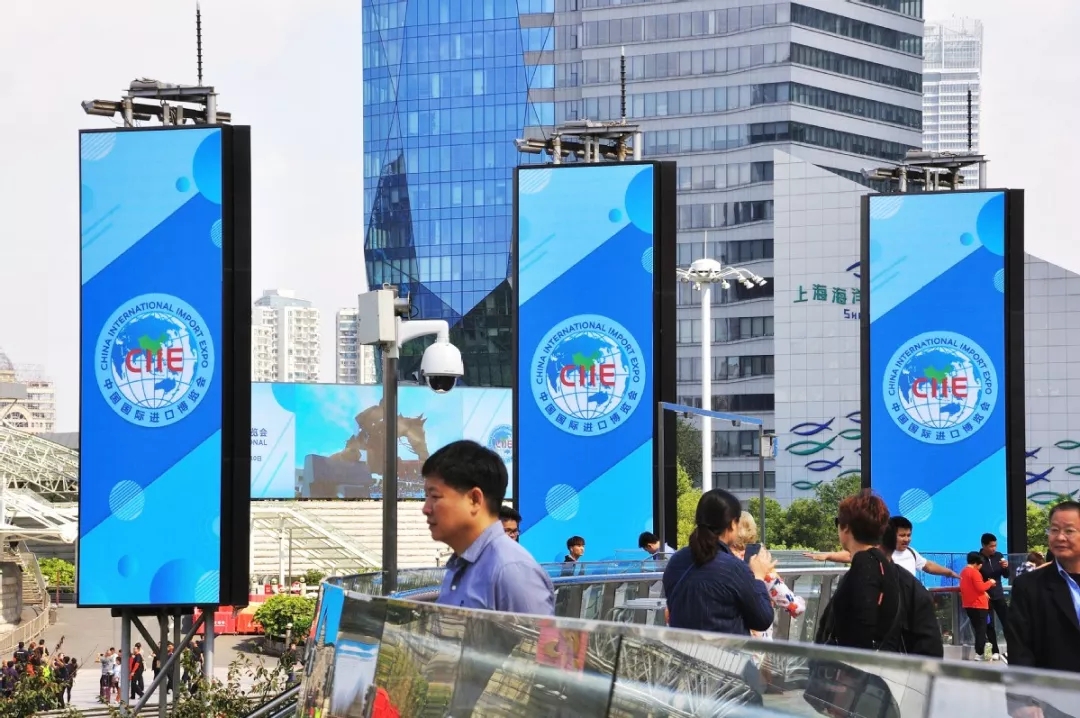
People walk past signs for the China International Import Expo in Shanghai’s Lujiazui area. [Photo provided to China Daily]
Mary Ma, general secretary in Shanghai for leading independent think tank the Center for China and Globalization, believes the expo can be compared with the Great Exhibition staged in London in the middle of the 19th century, and is a major opportunity for importers to showcase their products.
“Many have said it provides a ’six plus 365 opportunity’ – you exhibit at the show for six days and then you can sell online for 365 days. This is particularly the case with November 11 (Singles Day – China’s equivalent to Black Friday in the US – when online goods are heavily discounted) coming up,” she said.
Ma, who returned to China last year after working in Chicago for the International Trade Centre in Illinois on promoting exports to the country, said the purchasing power of younger people in China is something of a phenomenon.
“The one thing I noticed when I came back was the number of 20-to 30-year-olds in the shopping malls of Shanghai and Beijing. This is a huge market and I am not sure if the foreign brands do their best to reach it, particularly online.”
Joseph Healy, CEO at specialist lender Judo Capital in Melbourne, Australia, and author of Chinese Firms Going Global: Can They Succeed?, said the changing nature of China’s imports is beginning to have an effect on traditional resource exporters such as Australia.
“It used to be just an exporter of raw materials, but that is shifting. China’s growing middle class is a wonderful opportunity for Australia and New Zealand’s dairy products, wines and other products,” he said.
“On a political level, however, Australia has been pathetic in terms of engaging with this opportunity and has come across at times as quite disrespectful.”
Depoux, at Roland Berger, believes the expo will be a major opportunity for some of the countries – along with the Belt and Road Initiative – who have not exported to China before.
“I am thinking, in particular, of Central Asia and agricultural exports, but this might also be an opportunity for some African and South American countries to try to establish a market position in China,” he said.
However, he insists that while this market has huge potential, it also has its unique challenges.
“It is a very complex, fragmented and very fast-moving market. It often changes so fast that by the time you are thinking about moving in, it has changed again.”
With trade tensions escalating, many expo participants hope the event will demonstrate the importance of open trade.
Wang, at AstraZeneca, is confident that it will send an important signal.
“We greatly admire the foresight of the Chinese leadership in uniting the world ever more closely by hosting such an international event. China is an important engine for global economic growth and prosperity, and I am pleased the Chinese government supports globalization and free trade,” he said.
Wang Huiyao, president and founder of the Center for China and Globalization(CCG), agrees that the expo is a major opportunity for companies worldwide.
“China wants to buy more. It doesn’t want a trade surplus. This event is very significant and represents a major shopping opportunity for the Chinese,” he said.
From China Daily,2018-11-2
